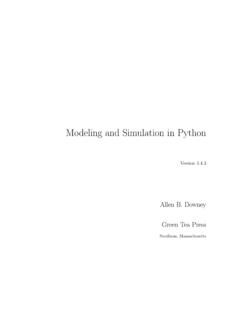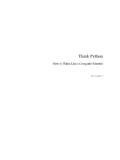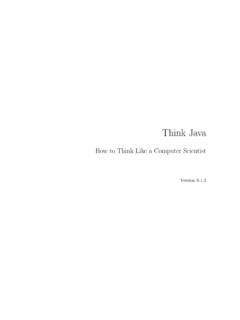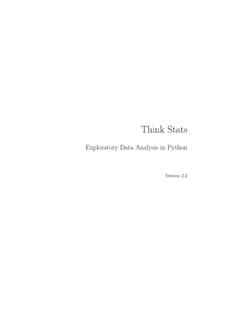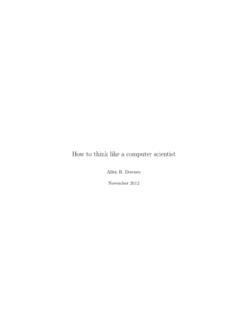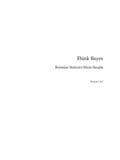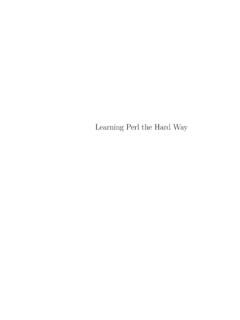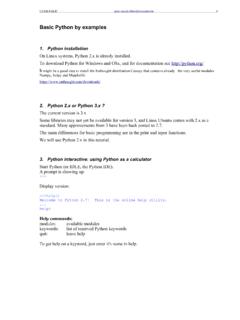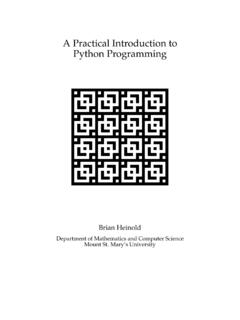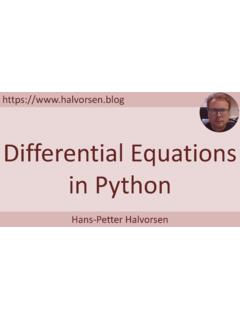Transcription of How to Think Like a Computer Scientist - Green Tea Press
1 How to Think like a Computer ScientistLearning with PythoniiHow to Think like a Computer ScientistLearning with PythonAllen DowneyJeffrey ElknerChris MeyersGreen Tea PressWellesley, MassachusettsCopyrightc 2002 Allen Downey, Jeffrey Elkner, and Chris by Shannon Turlington and Lisa Cutler. Cover design by Rebecca history:April 2002:First 2008:Second Tea Press1 Grove Box 812901 Wellesley, MA 02482 Permission is granted to copy, distribute, and/or modify this document under the termsof the GNU Free Documentation License, Version or any later versionpublished bythe Free Software Foundation; with the Invariant Sections being Foreword, Preface, and Contributor List, with no Front-Cover Texts, and with no Back-Cover copy of the license is included in the appendix entitled GNU Free DocumentationLicense.
2 The GNU Free Documentation License is available by writing tothe Free Software Foundation, Inc., 59 Temple Place, Suite 330, Boston, MA02111-1307, original form of this book is LATEX source code. Compiling this LATEX source hasthe effect of generating a device-independent representation of a textbook, which can beconverted to other formats and LATEX source for this book is available s Cataloging-in-Publication (provided by Quality Books,Inc.)Downey, AllenHow to Think like a Computer Scientist : learningwith python / Allen Downey, Jeffrey Elkner, ChrisMeyers. 1st 0-9716775-0-6 LCCN 20021006181. python ( Computer program language) I. Elkner,Jeffrey. II. Meyers, Chris. III. 3 QBI02-200031 ForewordBy David BeazleyAs an educator, researcher, and book author, I am delighted to see the completionof this book.
3 python is a fun and extremely easy-to-use programming languagethat has steadily gained in popularity over the last few years. Developed overten years ago by Guido van Rossum, python s simple syntax and overall feel islargely derived from ABC, a teaching language that was developed in the 1980 , python was also created to solve real problems and it borrows a widevariety of features from programming languages such as C++, Java, Modula-3,and Scheme. Because of this, one of python s most remarkable features is itsbroad appeal to professional software developers, scientists, researchers,artists,and python s appeal to many different communities, you may still wonder why python ? or why teach programming with python ?
4 Answering thesequestions is no simple task especially when popular opinion is on the side ofmore masochistic alternatives such as C++ and Java. However, I Think the mostdirect answer is that programming in python is simply a lot of fun and I teach Computer science courses, I want to cover important concepts inaddition to making the material interesting and engaging to students. Unfortu-nately, there is a tendency for introductory programming courses to focus far toomuch attention on mathematical abstraction and for students to become frus-trated with annoying problems related to low-level details of syntax, compilation,and the enforcement of seemingly arcane rules. Although such abstraction andformalism is important to professional software engineers and students who planto continue their study of Computer science, taking such an approach in an intro-ductory course mostly succeeds in making Computer science boring.
5 When I teacha course, I don t want to have a room of uninspired students. I would much rathersee them trying to solve interesting problems by exploring different ideas, takingunconventional approaches, breaking the rules, and learning from their doing so, I don t want to waste half of the semester trying to sort out obscuresyntax problems, unintelligible compiler error messages, or the several hundredways that a program might generate a general protection of the reasons why I like python is that it provides a really nice balancebetween the practical and the conceptual. Since python is interpreted, beginnerscan pick up the language and start doing neat things almost immediately with-out getting lost in the problems of compilation and linking.
6 Furthermore, Pythoncomes with a large library of modules that can be used to do all sorts of tasks rang-ing from web- programming to graphics. Having such a practical focus is a greatway to engage students and it allows them to complete significant projects. How-ever, python can also serve as an excellent foundation for introducing importantcomputer science concepts. Since python fully supports procedures and classes,students can be gradually introduced to topics such as procedural abstraction,data structures, and object-oriented programming all of which are applicable tolater courses on Java or C++. python even borrows a number of features fromfunctional programming languages and can be used to introduce concepts thatwould be covered in more detail in courses on Scheme and reading Jeffrey s preface, I am struck by his comments that python allowedhim to see a higher level of success and a lower level of frustration and that hewas able to move faster with better results.
7 Although these comments refertohis introductory course, I sometimes use python for these exact same reasons inadvanced graduate level Computer science courses at the University of these courses, I am constantly faced with the daunting task of covering a lot ofdifficult course material in a blistering nine week quarter. Although it is certainlypossible for me to inflict a lot of pain and suffering by using a language like C++,I have often found this approach to be counterproductive especially when thecourse is about a topic unrelated to just programming . I find that using Pythonallows me to better focus on the actual topic at hand while allowing students tocomplete substantial class python is still a young and evolving language, I believe that it has abright future in education.
8 This book is an important step in that BeazleyUniversity of ChicagoAuthor of thePython Essential ReferencePrefaceBy Jeff ElknerThis book owes its existence to the collaboration made possible by the Internetand the free software movement. Its three authors a college professor, a highschool teacher, and a professional programmer have yet to meet face to face,but we have been able to work closely together and have been aided by manywonderful folks who have donated their time and energy to helping make thisbook Think this book is a testament to the benefits and future possibilities of thiskind of collaboration, the framework for which has been put in place by RichardStallman and the Free Software and why I came to use PythonIn 1999, the College Board s Advanced Placement (AP) Computer Science examwas given in C++ for the first time.
9 As in many high schools throughout thecountry, the decision to change languages had a direct impact on the computerscience curriculum at Yorktown High School in Arlington, Virginia, where I to this point, Pascal was the language of instruction in both our first-year andAP courses. In keeping with past practice of giving students two years of exposureto the same language, we made the decision to switch to C++ in the first-yearcourse for the 1997-98 school year so that we would be in step with the CollegeBoard s change for the AP course the following years later, I was convinced that C++ was a poor choice to use for introducingstudents to Computer science. While it is certainly a very powerful programminglanguage, it is also an extremely difficult language to learn and teach.
10 I foundmyself constantly fighting with C++ s difficult syntax and multiple ways of doingthings, and I was losing many students unnecessarily as a result. Convinced thereviiiPrefacehad to be a better language choice for our first-year class, I went looking for analternative to C++.I needed a language that would run on the machines in our Linux lab as well as onthe Windows and Macintosh platforms most students have at home. I wanted it tobe free and available electronically, so that students could use it at home regardlessof their income. I wanted a language that was used by professional programmers,and one that had an active developer community around it. It had to supportboth procedural and object-oriented programming .

